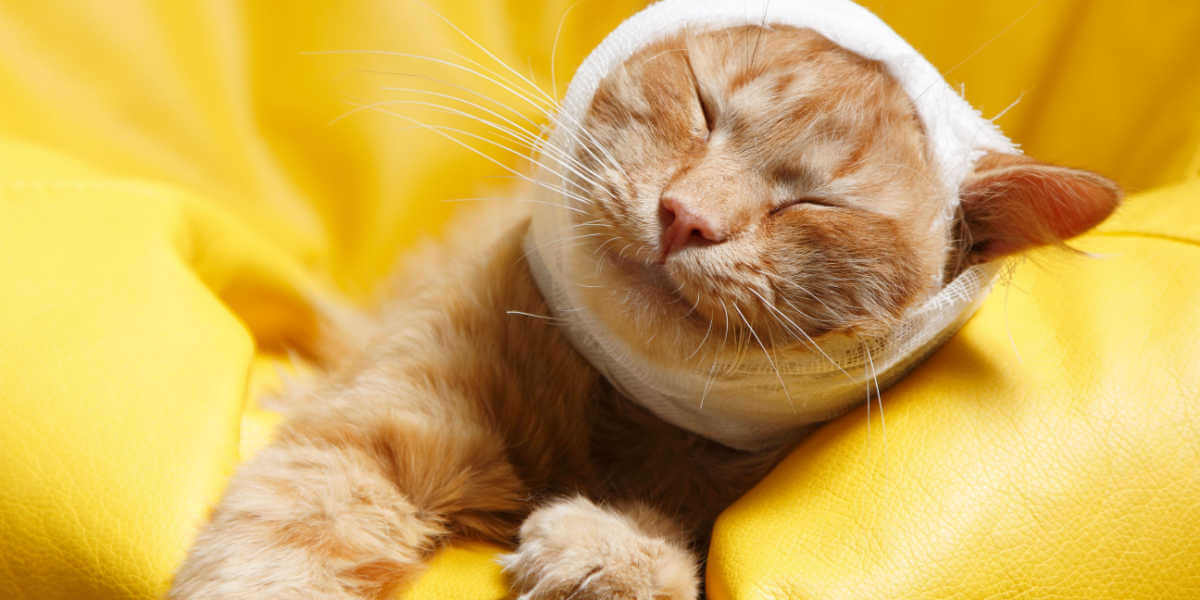
Head trauma in cats can be a very life-threatening medical condition, requiring early recognition of signs and treatment for the best outcome. In this article, you’ll learn the top 7 signs seen with head trauma in cats, as well as common causes, how injuries are treated, how to prevent these injuries, and some frequently asked questions.
What Is Head Trauma in Cats?
Head trauma in cats involves an injury to the skull and sometimes structures inside like the brain and nervous system. However, there can be minor and major head trauma. Most cats will be just fine after a small accidental knock on the head.
But a significant impact or injury from an object or due to a fall from a high place can lead to more severe effects. Skull fractures, including fractures of the nasal bones, can occur.
Even if a penetrating injury or fractures don’t happen, bleeding (hemorrhage) or swelling within the skull just from an impact or blunt trauma can lead to secondary injury to the brain from the increased pressure, which is called intracranial pressure (ICP). Increased ICP contributes to compression of the brain and poor oxygen supply to brain tissues (cerebral perfusion). These secondary effects can worsen with time, making it important for early evaluation and treatment.
Common Causes of Head Trauma in Cats
Unfortunately, head trauma in cats can be very common. And although the risk is higher for outdoor kitties, indoor cats have their share of risks as well.
Cats that roam outdoors, especially intact male cats, are always at a high risk of getting hit by a moving vehicle. Head trauma can also occur if a cat gets into a fight with another animal, especially a much bigger one, like a large dog.
Whether out of preference or as a result of trying to escape a source of danger, outdoor cats will also seek high-up locations, like trees and fences. Misjudging a jump or slipping off can lead to a bad fall.
Although cats are conditioned to land on their feet, this may not always happen if the location is too high, or if the cat’s judgment is impaired trying to escape a source of danger.
Indoor cats have their share of risks too. Cats can fall from bookshelves, cabinets, the fridge and similar high places. Often, reaching a high place is one thing, but some cats may have trouble finding a safe route back down. Cats can also misjudge what’s needed for a very high jump and may miss their landing or slip.
Cats living on a higher floor of an apartment building or townhouse who have access to a balcony or open window can suffer from an event called “high rise syndrome” where they can fall from a very high height and sustain injuries.
Besides falls, cats can also be subject to accidents caused by their human family. Preferring quiet, dark places like closets, under blankets and pillows, or beneath furniture, cats may be injured by being sat on or having a heavy object unknowingly placed on top of them.
Blunt trauma inside the home can also occur. Although this tragically may be intentional in some cases, accidents happen too. A common example is being hit in the head or fallen on top of by a young child in the frenzy of play in the home. Household objects like flower pots or vases may also get knocked and fall on them.
The Top 7 Clinical Signs of Head Trauma in Cats

Falls from high places can result in head trauma.
In a cat that has experienced a recent head trauma, there are important abnormalities to look for. These can help clue you into both the likelihood that head trauma has occurred, as well as how severe it may be.
1. Abnormal Behavior/Mentation
A cat experiencing head trauma may appear stunned, disoriented, and not completely aware. Mentation refers to a cat’s level of consciousness: their alertness and ability to process their surroundings. These changes may also be accompanied by abnormal vocalizing like loud meowing, yowling, or hissing.
2. Difficulty Walking or Standing
Along with a stunned and altered mental state, head trauma in cats can also lead to an inability to walk normally. A cat may have a hard time standing up. If a cat is walking, they may have trouble keeping balance, leading to stumbling and falling over.
3. Abnormal Eye Appearance and Movement
The pupils in a cat can be very small (miotic) or very large (mydriatic). Most of the time normally, a cat’s pupil size sits somewhere in between. If a cat’s pupils are about mid-size after head trauma, this is a very good sign.
Very small pupils can be seen in cases of pain from head injury. Very large pupils, especially in a cat that is poorly responsive after head trauma is the most concerning for brain trauma.
Abnormal movements of the eyes, which is called nystagmus, is also very concerning to see. This is an involuntary, often side-to-side movement of both eyes that occurs even though the cat’s head is kept perfectly still. This sign also supports potential traumatic brain injury if head trauma has occurred.
4. Head Tilt
A head tilt seen after head trauma in a cat raises concern for potential brain injury. Most often, a head tilt is also accompanied by abnormal eye movement. In most cases, the side the head is tilted towards is the side of the brain being most affected by injury.
5. Seizures
Seizures can occur after head trauma if brain damage has occurred. These can be immediate in severe cases, but may also be seen as long-term effects depending on the nature of the injury. Seizures can include the classic grand-mal seizures with loss of consciousness, convulsions, paddling, salivation, and loss of bodily functions.
More mild focal seizures can also be seen which can include head or limb twitching, brief periods of “spacing out”, or other involuntary motions occurring while a cat is still conscious.
6. Vomiting
Vomiting can happen for many reasons in cats. In the case of head trauma, vomiting is concerning to see, as it can occur with high intracranial pressure within the skull from bleeding or swelling, impacting the brain.
7. Loss of Consciousness
This is perhaps the most severe and concerning sign to see after head trauma. Most cats will still be conscious after a fall or impact. If a cat is not conscious, and especially if the pupils are very large, serious brain injury has likely occurred.
Diagnosis of Head Trauma in Cats

All cats with suspected head trauma should be taken to a veterinarian.
Because the signs discussed may occur separately with different situations and medical conditions, it’s important to get your kitty to your DVM as soon as possible if head trauma is suspected. A vet’s main task in cases of head trauma is to determine if swelling within the skull may be occurring, which can lead to loss of oxygen and injury to the brain.
During a physical examination, your vet may already see signs supporting a head trauma. This can include bleeding from the nose or mouth, broken teeth, cuts, scratches, or other wounds. Your vet will check your cat’s neurologic status for signs of serious concern that brain swelling or injury is present, including pupil size, abnormal eye movement, and an altered mental awareness and response.
In cases of suspected head trauma, or even just in cases of certain signs a cat parent may notice (such as a head tilt), your vet will be prompted to perform a more thorough neurologic examination.
Evaluating heart rate is also very important with head trauma. Most cats will have a very rapid heart rate if they’re distressed or in pain. If bleeding or swelling around the brain is occurring from trauma, the increased pressure inside the skull will lead to a very low heart rate (bradycardia). This finding is very serious, warranting emergency treatments.
Blood pressure is often taken in the case of any emergency. Most patients in shock from an injury will have a low blood pressure along with a high heart rate. But in the case of severe head trauma, the heart rate may be very low coupled by an abnormally high blood pressure. This combination, called the Cushing’s reflex, also warrants immediate emergency treatment for high pressure from swelling or bleeding within the skull.
Other tests may be advised in the case of head trauma, though they will only be indicated after a patient is stabilized. These may include:
- Radiographs (X-rays), which can be used to look for fractures.
- Computed tomography (a CT scan), which can be used to evaluate for both fractures and fluid swelling within the skull.
- Magnetic resonance imaging (MRI), which is best to look at the effects on the brain tissue itself.
- Blood tests, including checking blood gas and blood glucose
- Cerebrospinal fluid (CSF) sampling
Also Read: Cat Bloodwork (Different Types of Tests, Health Conditions And Costs)
Treatment of Head Trauma in Cats

Cats with severe head trauma may require oxygen therapy and other stabilization.
At the minimum, a cat who has experienced head trauma but has no serious effects like fractures or brain injury, will be provided with pain medication. For an outdoor cat, any open wounds will be cleaned and antibiotics may be prescribed.
In cats with very serious head trauma that results in bleeding or swelling within the skull, a focus of emergency efforts to provide oxygen and reduce pressure within the head is most important. A vet can tell if this is likely through the neurologic exam combined with heart rate and blood pressure.
Because the brain may be low on oxygen from trauma or pressure, oxygen support is provided throughout treatment, usually with a mask near or over the face. Fluid therapy is used to support blood pressure and blood volume. Certain intravenous fluids such as mannitol are used to help draw fluid out of the skull and relieve pressure on the brain. The earlier this care is provided, the better.
Active seizures may require anticonvulsant medications and any cats who are reactive or cannot be handled safely due to pain or altered behavior may require careful use of sedatives and additional pain medication.
Surgery for head trauma is less common. In cases of fractures, penetrating injuries to the head, or if medical attempts to reduce swelling within the skull are unsuccessful, surgical treatment may be pursued. Most often, any surgery involving the skull, brain, brainstem or spinal cord is performed by a board certified veterinary surgical or neurology specialist.
Also Read: 11 Signs That You Need to Get Your Cat To the Emergency Room
Prognosis for Cats With Head Trauma
For head trauma patients who have normal pupil size and no altered mentation or balance issues, prognosis for long-term recovery is excellent.
For cats that do show some of the abnormal signs discussed, long-term prognosis can depend on how quickly care with effective treatment is sought out. Quick treatment that reduces brain swelling and provides the brain with oxygen greatly reduces the secondary impacts on the brain and improves long-term results.
Prognosis can also depend on the nature of the injury and other injuries that occur to the body. A cat that has been hit by a car or falls from a 5th-story building is likely to have other bodily injuries that can cause complications.
Cats with brain injury from head trauma that make a good immediate recovery may still have some lasting effects for weeks or even months. These cats can still have some balance and mentation changes, trouble eating, or seizures that require supportive care, nutritional support, management at home and further follow-up. But even with some permanent changes, a cat with effects of head trauma and brain injury can still have a good quality of life.
Also Read: How To Keep Your Cat From Jumping After Surgery
Prevention of Head Trauma in Cats
Cats will be cats and sometimes completely preventing head trauma is not always possible, but there are ways to reduce risk.
- Outdoor cats are always at higher risk. Keeping a cat indoors can significantly reduce risk, especially from moving vehicles, fights with other animals, and falls from trees, fencing, or buildings.
- For indoor cats, be aware of high places your cat may attempt to reach. Either find a way to block off that area, or provide a safe way for your cat to reach this area and get back down.
- Evaluate your home for any heavy objects that could fall on your cat from a high place.
- If you live on a higher floor of a building, be cautious allowing access to open windows or balconies. There are many screened-in playpens available that are much safer for your cat to enjoy the outdoors.
- If young children are in the home, supervise play with pets nearby and encourage awareness of surroundings and how actions can impact furry family members.
- Head trauma can also occur when traveling in a vehicle with your cat if there are sudden stops, turns, or an unfortunate accident. Always make sure your cat is safe, secure, and comfortable in a carrier (preferably in a back seat) and that the carrier itself is secured as well.
Conclusion

Keep cats away from unsafe, high places where possible to reduce injuries.
Head trauma in cats can unfortunately be a common occurrence due to both cat preferences and behavior as well as accidents. Outdoor cats are at higher risk from certain injuries, but indoor cats have a share of risk as well. In any case of head trauma, early recognition and treatment can be vital to limiting brain injury and helping with a more favorable long-term prognosis.
Also Read: New Cat Owner Anxiety: Why It Happens & How To Overcome It
Frequently Asked Questions
How do I know if my cat has head trauma?
If you witness a fall or impact injury and your cat is not looking or behaving normally afterward, head trauma should be suspected. If a trauma event was not witnessed, it’s more important to seek veterinary care if signs of concern are seen, whether head trauma is suspected or not.
These signs can include abnormal behavior, altered ability or inability to walk, a depressed or dull mental state, and vocalizing from pain or distress. If your cat ever shows signs like these, it’s important for veterinary evaluation as soon as possible. Another cause may be responsible, but your veterinarian will determine the best tests and treatments.
What does head trauma look like in cats?
Head trauma may lead to external injuries like cuts, scrapes, or bleeding from the nose or mouth. However it may not always be apparent from wounds on the head itself. Changes to a cat’s mental state and behavior like lethargy, dullness, and poor responses can be present.
Head trauma may also result in changes to eye appearance, position, and movement. A cat may not be able to stand or walk normally, experiencing pain or balance issues.
Because some of these changes can be delayed from bleeding or swelling of or around the brain that is not visible, it’s very important for quick evaluation if head trauma is suspected.
What happens if a cat hits their head hard?
If an impact is hard enough, a cat can suffer from a concussion, just like a person can. The impact can lead to bleeding and swelling of the brain or tissues surrounding it. Because the skull is a rigid, fixed structure, the increased pressure from bleeding and swelling causes compression of the brain, poor blood flow, and a lack of oxygen reaching brain tissues.
These changes are what lead to the signs of head trauma and brain injury like a dull or depressed mental state, problems walking and moving, and other neurologic changes.
Can cats recover from head trauma?
Yes, cats can recover from head trauma. Recovery does depend on the severity of the injury, as well as any other injuries that occurred to other places of the body too. Early recognition of signs of head trauma is vital to ensure veterinary care is sought out as soon as possible.
With early and appropriate veterinary care to reduce effects of secondary brain injury from bleeding or swelling, the long-term prognosis and recovery will be greatly improved.
-
“Head Trauma in Cats in Common”. Catnip. Tufts University Cummings School of Veterinary Medicine. Published April 1, 2013. Accessed April 6, 2022. https://www.tuftscatnip.com/emergencycare/head-trauma-in-cats-is-common/
-
Hopper, Kate. “Head Trauma”. World Small Animal Veterinary Association World Congress Proceedings. 2008. Accessed April 6, 2022.
https://www.vin.com/apputil/content/defaultadv1.aspx?id=3866677&pid=11268
-
Jha SK. Cerebral Edema and its Management. Med J Armed Forces India. 2003 Oct;59(4):326-31. doi: 10.1016/S0377-1237(03)80147-8. Epub 2011 Jul 21. PMID: 27407555; PMCID: PMC4923559.







